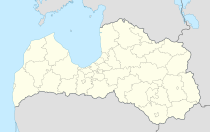Viļāni
| Viļāni ( German : Welons) | ||
|---|---|---|
 |
|
|
| Basic data | ||
| State : |
|
|
| Landscape: | Latgale ( Latvian : Latgale ) | |
| Administrative district : | Viļānu novads | |
| Coordinates : | 56 ° 33 ' N , 26 ° 55' E | |
| Residents : | 3,156 (Jan. 1, 2016) | |
| Area : | 4.9 km² | |
| Population density : | 644 inhabitants per km² | |
| Height : | ||
| City law: | since 1928 | |
| Website: | www.vilani.id.lv | |
| Post Code: | ||
| ISO code: | ||
Viļāni (dt. Welonen ) is a city in eastern Latvia in the heart of the historic Latgale landscape . In 2016 it had 3,156 inhabitants.
history
The place was first mentioned in 1495 under the name Wielona . In the 16th century this was one of the largest country estates in Latgale. In 1752 M. Riks bought the town and had a positive influence on its development. Under his leadership, a monastery and the church of St. Michael were built in the baroque style. The city was involved in the Polish uprising in 1830 .
The city's location on the Riga - Rēzekne trade route pushed the development forward again in the 19th century. In 1839 the town came into the possession of Vincent Janovskis , who had one of three modern linen weaving mills in the Russian Empire run in Viļāni at the beginning of the 1850s . 177 workers were employed here. An English engineer supervised the machines.
At that time there was also Russia's largest leather production facility in Viļāni, which supplied the tsarist army with belts, bags, footwear, saddles and leather accessories. There were also other smaller factories at the site, such as breweries, lime kilns , a brick factory and some spinning and weaving mills. In 1862 Viļāni were granted market rights.
The First World War slowed down further development. The city's factories were evacuated to Yaroslavl with parts of the population .
In 1924 the monks and priests Benedikts Skrinda and Bronisław Valpitrs came to Viļāni to revive the abbey and to renovate the monastery. the building was given a 2nd floor. In 1925 Viļāni had a Latvian, Russian and Jewish school. In 1928 it was granted city rights . At that time Viļāni extended over an area of 1.63 km² and owned 65 trading companies.
During the Second World War , the city was badly damaged in fighting in 1944, with considerable casualties among the civilian population.
In 1950 a hydropower plant was built on the Malta River .
Today there are 58 companies in Viļāni, including one for wood processing, a manufacturer of charcoal and the printing house Katoļu dzeive (Catholic literature). There has been a local television station since 1992.
Culture and sights
Viļānis Catholic Church, the monastery and the manor house with park are the most striking architectural buildings in the city. The monastery complex with inner courtyard, an excellent example of the architecture of the Cistercian monastery , is one of the most extraordinary structures in Latvia. The city's train station is also one of the sights, as is the city history museum and the Viļānis forest museum with around 100 animal exhibits. The Lakstīgalu sala ( Eng . Nightingale Island) is a recreational site near the city with an open-air stage that is actively used by the residents.
literature
- Astrīda Iltnere (ed.): Latvijas Pagasti, Enciklopēdija. Preses Nams, Riga 2002, ISBN 9984-00-436-8 .
